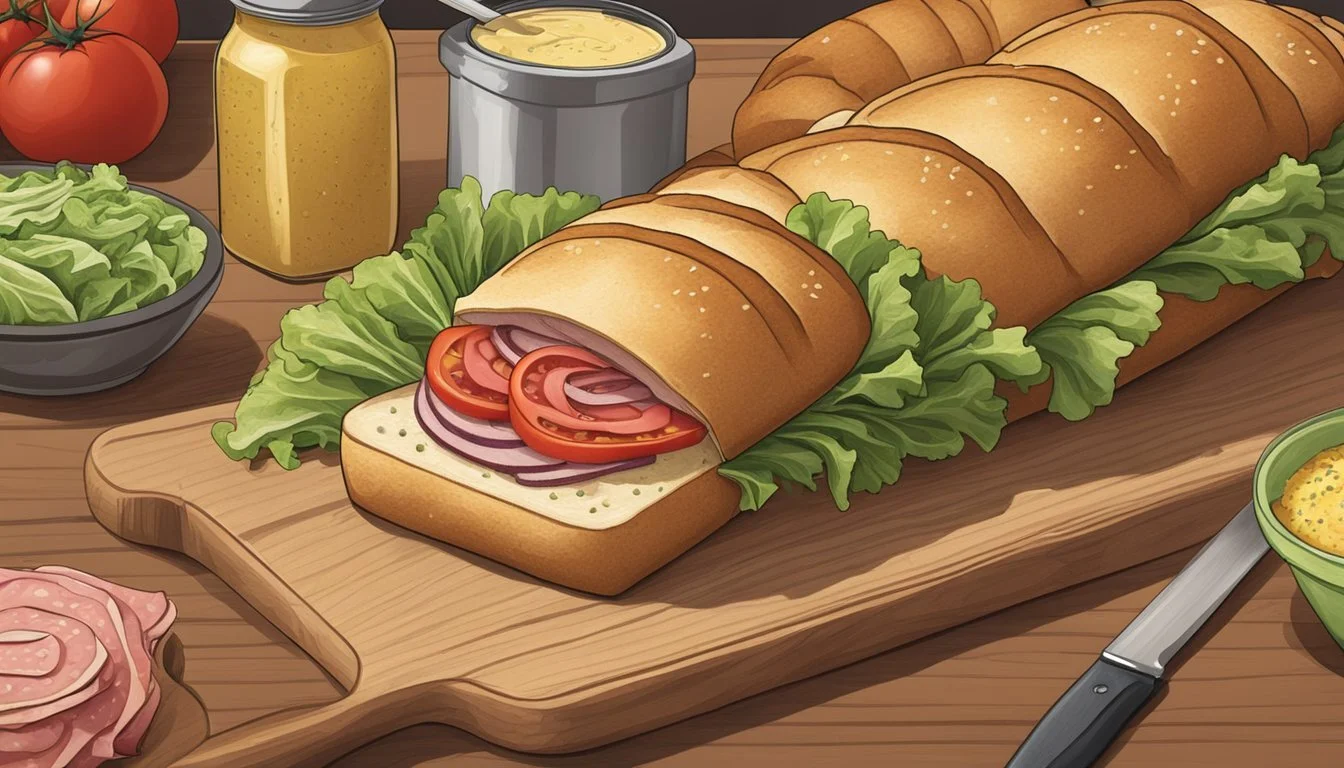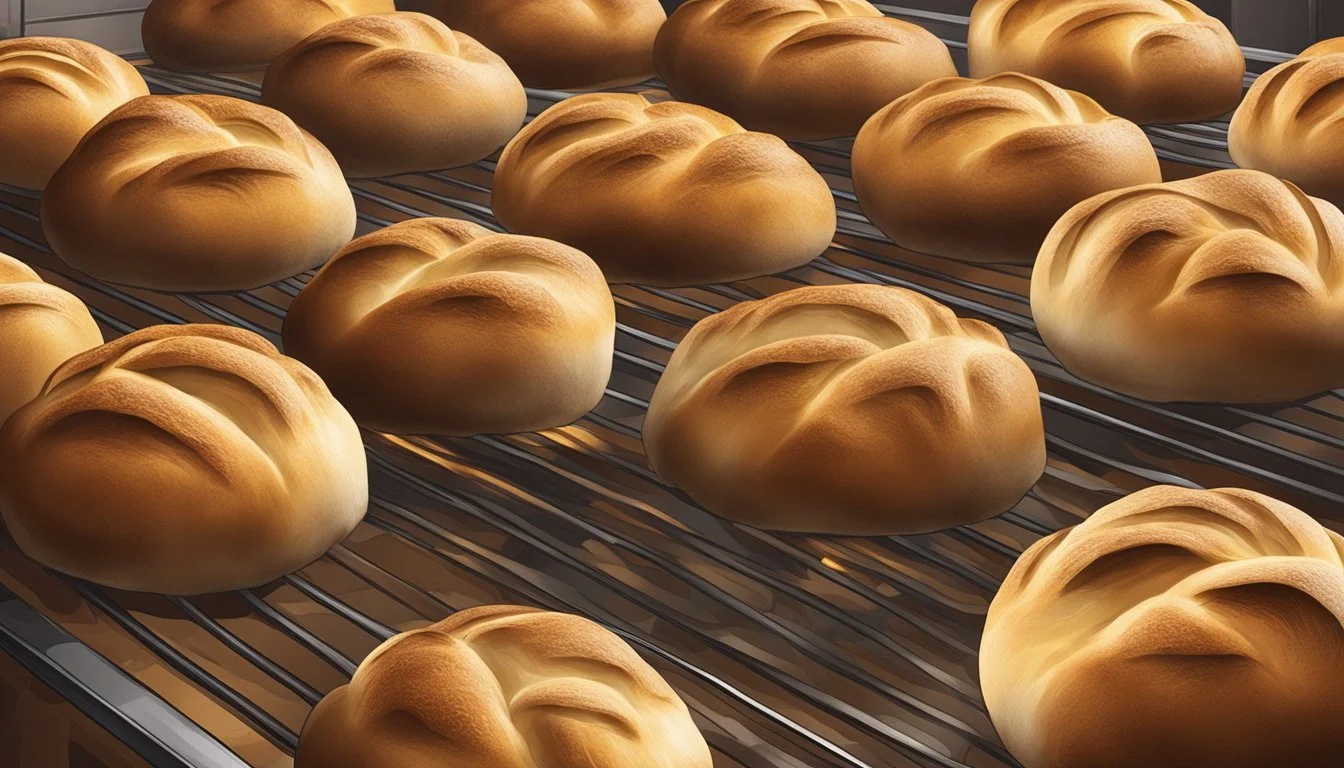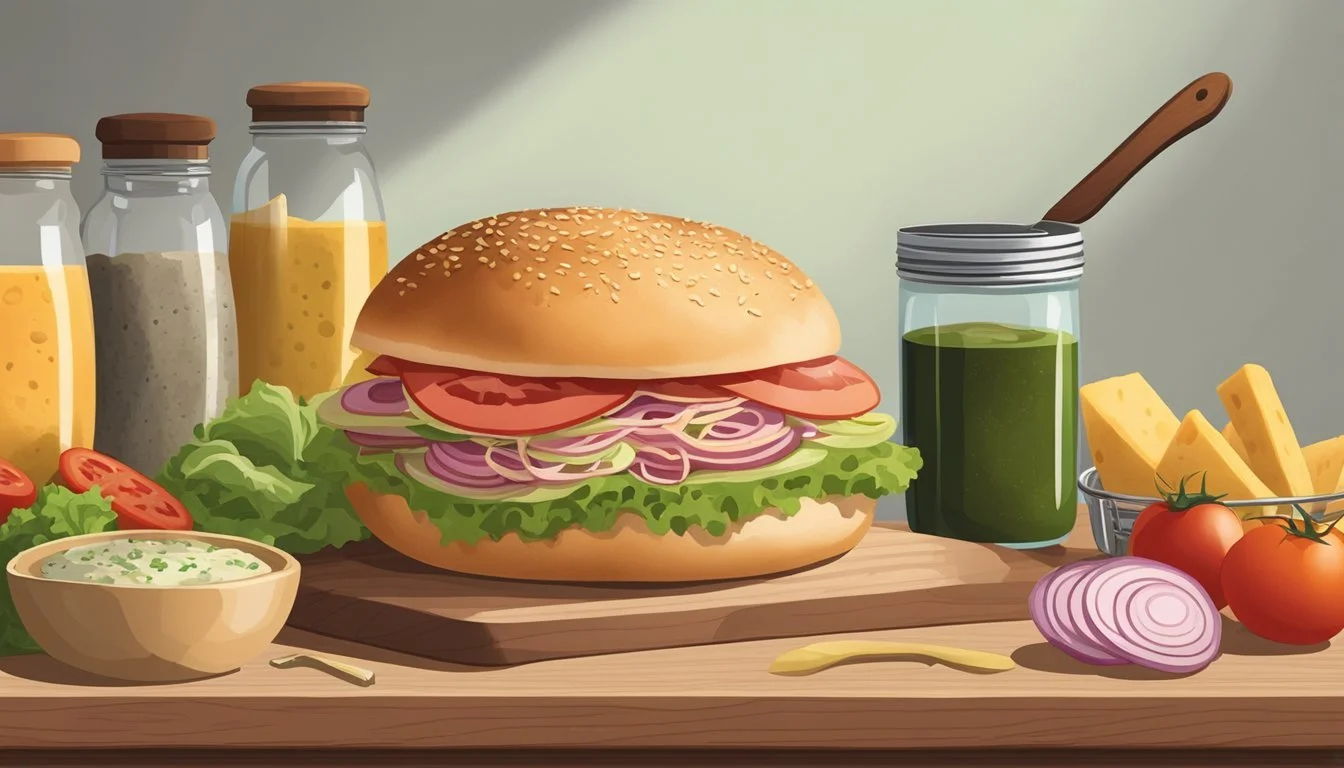How Do You Eat a Kaiser Roll?
Tips for Enjoying This Classic Bread
A kaiser roll, known for its distinct crusty exterior and soft interior, is a versatile bread (how long does bread last?) that has made a mark on breakfast tables and sandwich menus alike. Its origin traces back to Austria, but it has become a staple in various cuisines due to its distinct star-shaped pattern on top. This yeasty roll is not just another piece of bread; its firm structure makes it an ideal candidate for a range of culinary uses, from a simple buttered roll to a robust sandwich base.
When it comes to enjoying a kaiser roll, the options are plentiful and can accommodate a wide array of dietary preferences. In the morning, one might slice a kaiser roll in half and toast it to golden perfection, pairing it with butter, jams, or other spreads for a classic breakfast. Alternatively, its sturdy yet pliable crumb structure ensures it holds up well as the foundation for various sandwiches (What wine goes well with sandwiches?) a match for cold cuts, cheeses, grilled vegetables, (What wine goes well with grilled vegetables?) or burgers. Each bite introduces a satisfying crunch followed by the pillowy softness underneath, commending it as a bread that complements rather than competes with its fillings.
History of the Kaiser Roll
The Kaiser roll, known in Austria as Kaisersemmel, is a staple of traditional Austrian baking and has roots deeply entrenched in European culinary history. The roll is often associated with German-speaking countries and is characterized by its round shape and distinct, ornate imprint on top that resembles a crown, cementing its association with imperial symbolism.
Origin: The bread is purported to have been named after Emperor (Kaiser) Franz Joseph I of Austria, although the specifics of this naming are surrounded by various legends and anecdotes. What is clear, however, is that the Kaiser roll has been a part of Austrian cuisine for centuries.
Ingredients and Preparation: Traditionally, the Kaiser roll is created from a simple, yet precise recipe which calls for:
White flour
Yeast
Malt
Water
Salt
The top of the roll is its defining feature, typically divided into a series of segments—often five—that are folded in a way to represent a crown, another nod to its imperial association.
Cultural Significance: In Austria and across Central Europe, the Kaiser roll is not just a bread; it's part of the region's gastronomic identity. Its cultural significance is reflected in its name and presentation, which have remained consistent for many years, underscoring its connection to the region's history and heritage.
Modern Variations: While the roll maintains its traditional characteristics, there have been minor variations in recipes over time, occasionally including ingredients like sugar or butter for a different flavor profile or texture. However, the fundamental aspects of the roll remain unchanged, ensuring that the Kaiser roll continues to be a beloved item in Austria and beyond.
Ingredients and Substitutes
Crafting the perfect Kaiser roll involves a fine balance of ingredients to achieve the classic taste and texture. This section will guide readers through the required basic ingredients, enhance the taste and texture with additional components, and suggest substitutes for common allergens.
Basic Ingredients
Flour: The most common types used are bread flour and all-purpose flour. Bread flour is preferred for its higher gluten content, which gives the rolls their characteristic chew.
Ingredient Quantity Bread Flour Variable Salt To taste Water Variable Yeast (active dry or instant) Variable Sugar Variable
Salt is essential for flavor and yeast regulation. Water activates the yeast and hydrates the flour, creating the dough. Yeast, whether instant or active dry, is the leavening agent that causes the dough to rise. A small amount of sugar is often added to feed the yeast and enhance browning.
Additional Ingredients for Flavor and Texture
To elevate the taste and texture of Kaiser rolls, ingredients such as milk, butter, honey, malt powder, caraway seeds, sesame seeds, and poppy seeds are frequently incorporated.
Milk softens the dough while butter introduces a rich flavor and tender crumb. Honey and malt powder can contribute a slight sweetness and aid in crust browning. Seeds like sesame and poppy add a nutty flavor and a delightful crunch. Caraway lends a distinct aroma and taste, but is less commonly used.
Substitutes for Common Allergens
For individuals with dietary restrictions, several substitutes exist:
Flour: Gluten-free flour blends can replace bread or all-purpose flour, though the texture might be slightly different.
Dairy: Dairy-free alternatives, such as plant-based milks or margarine, can be used in place of milk and butter.
Eggs: If the recipe calls for eggs (not traditionally used in Kaiser rolls but sometimes included), egg substitutes like flax or chia seeds can be utilized.
Preparing the Dough
The creation of kaiser roll dough involves precise mixing and kneading to develop the gluten, followed by a specific proofing process to allow the yeast to do its work, finally culminating in the division and shaping into the traditional kaiser roll form.
Mixing and Kneading
In a stand mixer's bowl, combine the bread flour—known for its higher protein content—with the yeast. If using instant yeast, it can be added directly to the dry ingredients; for active dry yeast, proof it in warm water first. Start the mixer on a low setting using the dough hook attachment to mix ingredients until they come together. Then, increase the speed slightly and continue to knead for about 10 minutes, or until the dough is smooth, elastic, and slightly tacky to the touch.
Proofing the Dough
Transfer the dough to an oiled bowl, ensuring it is turned once to coat it with oil. Cover the bowl with plastic wrap and place in a warm place to rise. The dough should be allowed to double in size, which typically takes about 1 to 1.5 hours. The test of readiness is a gentle finger poke; if the indentation remains, the dough has sufficiently risen.
Dividing and Shaping
Once the dough has doubled, gently punch down to release any air bubbles. Turn the dough out onto a lightly floured work surface, divide it into equal pieces, and roll them into smooth, tight balls. Using a kaiser roll stamp or by hand, shape each ball into a classic kaiser roll shape, forming knots or ropes as necessary to achieve the traditional star pattern. This requires a gentle yet deliberate hand to avoid deflating the dough too much, preserving the light texture of the rolls.
Baking the Kaiser Rolls
The baking process is integral to achieving the perfect crust and texture in Kaiser rolls. It involves specific temperatures and techniques to ensure a golden brown finish and a delightful taste experience.
Preheating the Oven
Prior to baking, it's essential to preheat the oven. The correct temperature is typically 425°F (220°C) for a conventional oven or 428°F to 445°F (220°C to 230°C) if using a convection oven. This high temperature is necessary to create the right crust and color on the rolls.
Baking Process
Once preheated, the rolls should be placed on a baking sheet lined with parchment paper to prevent sticking. Baking the rolls for approximately 15 to 17 minutes will usually suffice, but ovens may vary, so it's crucial to look for that golden brown hue that indicates they are done. The introduction of steam, by placing a pan of hot water in the oven during baking, can help achieve a pronounced crust with a glossy surface.
Cooling on a Wire Rack
After baking, it's important to transfer the Kaiser rolls to a wire rack to cool. Cooling on the rack ensures even air circulation, which helps maintain the crust's crispness and prevents the bottoms from becoming soggy. The rolls should feel light to the touch, indicating that they've been baked through and have developed the right texture.
The Kaiser rolls are now ready to be enjoyed with the filling of your choice.
Toppings and Serving Suggestions
Kaiser rolls, with their distinct crusty exterior and soft interior, are a versatile bread choice suitable for a variety of toppings. Whether relished as a breakfast item or enjoyed as a lunchtime sandwich roll, these rolls can be paired with both sweet and savory additions to suit any taste.
Traditional Toppings for Kaiser Rolls
One can begin their day with a kaiser roll lightly toasted and spread with butter, which complements the roll's slight crunch. For a sweeter start, spreads such as jam or honey are perfect, adding a burst of flavor to the mild bread. The rolls' tops are often sprinkled with sesame seeds or poppy seeds, adding a subtle texture and nutty taste which enhances the overall flavor profile.
Sesame seeds: Nutty, with a hint of crunch.
Poppy seeds: Slightly sweet, adds texture.
Butter: Rich and creamy.
Jam: Sweet and fruity.
Honey: Natural sweetness.
Pairing with Meats and Cheeses
For lunchtime, a kaiser roll transforms into a hearty sandwich roll. The robust structure holds up well to an assortment of deli meats (how long do deli meats last?) — from classic ham and turkey to more flavorful options like pastrami or salami. One can layer on slices of cheese, such as Swiss, cheddar, or provolone, to add creaminess and depth. The kaiser roll can also serve as an ideal hamburger bun due to its sturdy nature, elevating the classic burger experience.
Deli meats: Ham, turkey, pastrami.
Cheese: Swiss, cheddar, provolone.
Hamburger bun: Sturdy and enhances burgers.
These combinations for kaiser rolls provide a simple yet satisfying meal that satisfies diverse palates and dietary preferences.
Storing and Preserving Freshness
Ensuring the freshness of kaiser rolls is crucial for maintaining their texture and taste. Proper storage at room temperature or in the freezer can significantly prolong their life without sacrificing quality.
Storing at Room Temperature
Kaiser rolls should be stored in an airtight container or wrapped securely in plastic wrap to retain their moisture and softness. After the rolls have completely cooled, they can be kept at room temperature. To further protect them from drying out, one might also wrap the rolls in a kitchen towel before placing them in the container. Typically, they will remain fresh for 2-3 days when stored this way.
Freezing and Thawing
For longer storage, kaiser rolls can be frozen where they will retain their quality for up to 2-3 months. To freeze the rolls, one should first ensure they are at room temperature to prevent condensation from forming, which could lead to a soggy texture upon thawing. Wrapping the rolls individually in plastic wrap and then placing them into an airtight container or a resealable freezer bag is recommended. When ready to use, allow the rolls to thaw at room temperature. They can then be refreshed in the oven for a few minutes if desired, to restore the crust's crispness.
Creative Uses for Kaiser Rolls
Kaiser rolls, with their crunchy exterior and soft interior, serve as a versatile bread choice for a variety of meals. They are a popular option for sandwiches due to their sturdy structure that holds up well with an array of fillings.
Breakfast Delight: These rolls can be sliced in half to create a hearty breakfast sandwich. They recommend cooking bacon until it's crispy, then frying an egg in the remaining bacon (how long does bacon last?)fat for added flavor. The roll can be toasted for a crunchier texture. Enhanced with mayonnaise, slices of avocado, and topped with the bacon and egg, the sandwich can be seasoned with salt and pepper for a simple yet satisfying meal.
For lunch or dinner, kaiser rolls can elevate a classic burger. They can withstand the juiciness of the patty without becoming soggy. Adding lettuce, tomato, and your favorite condiments completes this traditional yet flavorful dish.
Grilled to Perfection: Those who enjoy the smoky taste that a grill provides can benefit from grilling their kaiser rolls. They can be lightly buttered and placed on the grill for a short time until grill marks appear, adding a unique toasted flavor and texture that complements both burgers and grilled chicken sandwiches.
Versatile Toast: Furthermore, when sliced and toasted, kaiser rolls can act as a base for various toppings like avocado or a spread of garlic butter, transforming them into a simple and flavorful toast appetizer or snack.
Meal Time Suggested Use Breakfast Egg and bacon sandwich with mayo and avocado Lunch Classic burger with lettuce, tomato, condiments Dinner Grilled chicken sandwich with toasted roll Snack Toasted with avocado or garlic butter spread
With these suggestions, anyone can use kaiser rolls to create delicious, satisfying meals throughout the day.
Troubleshooting Common Issues
When baking Kaiser rolls, bakers may encounter a few common issues that affect the quality of their bread. By understanding how to address these problems, one ensures that the rolls are delicious and have the right texture.
Dough Not Rising
A major factor for dough not rising is inactive yeast. To ensure the yeast is active, it should be fresh and proofed in warm water with a pinch of sugar before adding it to the flour. The dough should be placed in a warm, draft-free area to rise properly. If the yeast is old or the environment is too cool, the rise will be insufficient.
Excessively Dense Texture
Kaiser rolls should be light and airy. If the rolls are too dense, this may be due to over-kneading or not enough water in the dough. It is essential to knead the dough until it's smooth and elastic but not beyond that point. The dough should be tacky to the touch without being overly sticky. Incorporate water gradually to achieve the right hydration level for a pliable dough that holds its shape.
Uneven Baking
To avoid uneven baking, rolls must be uniformly shaped and spaced apart on the baking sheet. Rolls should be baked in the preheated oven at a consistent temperature. If rolls are browning too quickly on the top or bottom, one may need to adjust the oven rack's position or use parchment to prevent direct heat. A baking sheet without warping helps ensure even heat distribution. For a golden-brown crust, a steaming technique can be used by placing a shallow pan of water in the oven during the first few minutes of baking.










